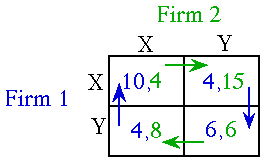Suggested Answer to HW7-3(b)3. (b)

There are no Nash equilibria in the above game. Whatever cell
we are in, at least one of the players would like to change her
play given that the other player would stay with the current strategy.
For example, consider the cell in which Firm 1 plays Y and Firm
2 plays X. If Firm 2 stays with x, Firm 1 would like to switch
to x. Then, if both are playing X, Firm 2 would like to switch
to Y and so forth. The colored arrows show how each firm would
like to change its strategy if the other firm maintains its strategy.
No cell is a Nash Equilibrium if one or more players would change
strategies if the other does not.
In such a game a common result is that players might choose to
play mixed strategies. Even though it is beyond this course to
compute the appropriate probabilities of a mixed strategy nash
equilibrium in this case, such an equilibrium does exist.
Finally, in a situation in which collusion is easy, we can at
least consider the possibility that Firm2 can offer payments sufficient
to induce Firm 1 to play X so that Firm 2 can play Y thus maximizing
total payoffs to the two firms.

© 1995-1999 EconWeb - All Rights Reserved


